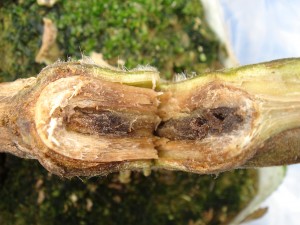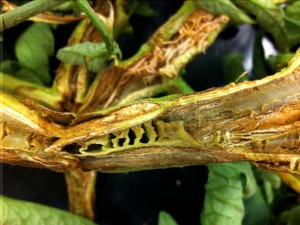What Is It? | Facts in Depth | For the Professional Diagnostician
Tomato Diseases | Tomato Pith Necrosis Fact Sheets
Tomato Pith Necrosis
Identification
Pith necrosis appears randomly in the field or high tunnel and symptoms are generally first observed when the first fruit cluster reaches the mature green stage. Foliar symptoms of pith necrosis are similar to bacterial canker symptoms and can’t be used to reliably identify these diseases. Foliar symptoms include chlorosis of young leaves followed by wilting in the upper portion of the plant canopy (top wilting). Large necrotic lesions that are brownish-gray in color can be found on the stems and petioles of the plant. These lesions are often cracked or collapsed. When stems are cut longitudinally, the pith can be severely degraded or hollow, dark brown to black in color and/or have a ladder-like appearance. The stems may also appear swollen or have a large number of adventitious roots associated with them. Although the disease is sporadic, sudden plant death is not uncommon.
Symptoms may be observed on immature fruit but are rare. Symptoms on fruit originate from the blossom end of the fruit. Immature fruit have large dark brown to black regions with a greasy water-soaked margin.



Pathogen Biology
The pathogens associated with pith necrosis are considered weak pathogens and are ubiquitous in the soil. Plant debris and contaminated mulches can also be sources of the pathogens. Plants are most susceptible to infection during vigorous vegetative growth due to exposure to high levels of nitrogen fertilizer.
Favorable Environmental Conditions
Optimal conditions for pith necrosis are cool night temperatures, high humidity and prolonged periods of cloud cover.
Often Confused With
- Bacterial Canker – Bird’s eye spots are observed on fruit with bacterial canker. The pith of stems with bacterial canker appears white and spongy.
- Bacterial Wilt – Leaves wilt and plants collapse suddenly. Brownish discoloration begins in vascular tissue but moves into the pith later. Copious amounts of bacteria stream into water from infected stems and can be seen with the naked eye. Similar bacterial streaming not observed for pith necrosis. Bacterial wilt is extremely rare in temperate climates in the US.

Scouting Notes
The disease occurs randomly within a field or high tunnel and is generally limited to a few plants. It is not uncommon to see one or two dead plants without having observed any prior symptoms. The pathogen is most active when the plant is growing too rapidly due to excessive soil nitrogen levels. Foliar symptoms of pith necrosis are similar to early bacterial canker disease symptoms and should not be used to confirm the disease. Symptomatic plants should be sampled immediately and submitted for plant disease diagnosis to rule out bacterial canker. pith necrosis disease progression is slowed during warm and sunny periods and plants may recover from the disease once fertility conditions are corrected.
Thresholds
No thresholds have been established for this disease.
Management Notes
Pith necrosis is a frustrating disease for many growers because seemingly healthy plants can die suddenly. Because the pathogens causing pith necrosis are weak pathogens and ubiquitous in the soil, strategies that prevent the establishment of favorable growth conditions for these pathogens are the only means of management.
- Start with clean seed and transplants – Although pith necrosis has not been shown to be seed-borne, starting with certified, disease-free seed or transplants is recommended to manage other bacterial diseases that are seed-borne.
- Start with a clean field – The pathogens that cause pith necrosis can be introduced into a field on contaminated crop debris. Avoid planting in a field with existing crop debris or that has been used to hold cull piles.
- Avoid early plantings – Delay planting in springs that are cool and wet as these environmental conditions favor the pith necrosis pathogens.
- Use best cultural practices – Use management strategies that maintain reduced-stress growing conditions. Avoid excessive nitrogen rates, especially in the spring when vegetative growth is rapid.

